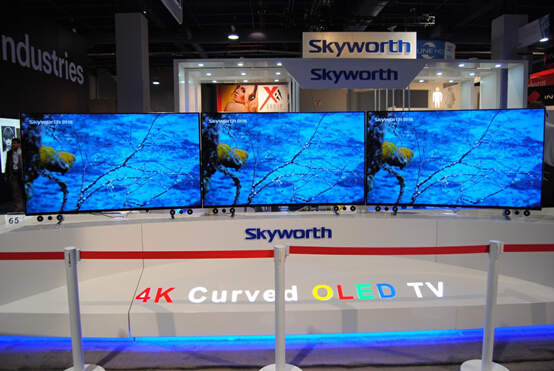Skyworth announced on Aug. 25 that its first mass-produced 4K OLED TVs will soon hit the market and that it is targeting sales of 30,000 units this year. Liu Tangzhi, CEO of Skyworth’s TV division, said the company has been preparing for the product launch for two years and can now go ahead with its plans after LG Display began mass production of 4K OLED panels in June.
Liu said OLED TVs can be made even thinner than LCD panels because the former are not backlit, and OLED technology also achieves deeper black levels and better contrast than other screens.
Liu forecasts that the penetration of OLED TVs will reach 15%-20% of overall TV sales by unit and 30% of sales by value in 2020.
Liu Dan, president of Konka, which plans to begin selling 4k OLED TVs on Oct. 1, said OLED TV prices have dropped to only double the price of LCD units and now is the time to introduce such products to the market.
When the price drops to only 20% higher than LCD units, OLED TVs will begin to replace LCD units on a large scale, according to the Konka president.
That threshold may still be far away, however. Sigmaintell Consulting vice president Li Yaqin said LCD panel prices have dropped rapidly because of a supply glut, making it difficult for OLED products to compete against the low prices of LCD TVs.
While Skyworth and Konka have bet on OLED technology, local rival HiSense believes the Ultra LED (ULED) products it has developed present a better option, and it sees laser TVs as the future of the television industry, the report said.
What is Ultra LED (ULED)?
ULED is an accurate LED backlight control technology (that uses small crystals 5-20 nanometers in size) to produce an enhanced picture. This technology is based on dynamic backlight control, local dimming and a wide color gamut that improves your viewing experience.
The largest of the two Hisense ULED sets announced so far, the Hisense 65H10B (Amazon exclusive pre-order, $2,999) ULED TV has a stellar resume that could see it squaring off against heavy-hitters in the value segment like Vizio’s P-series and higher-end options like Samsung’s SUHD models.
This first impression is based on the side-by-side-by-side shootout between the Samsung UN65JS9000 and the LG EG9600—two of the best TVs we’ve ever tested.
The typical price for a 4K OLED or an HDR-compatible, 4K LED TV with quantum dots starts around $5,000. The 65-inch H10B2 promises similar performance and hardware for just $2,999.
Hisense’s ULED and Samsung’s SUHD use quantum dot color, LG’s OLED—an emissive display—doesn’t. During testing, it was found that while OLEDs typically produce much more color than simple HD televisions, they are not quite as vibrant as the newer quantum dot displays we’ve seen—though this varies between manufacturers and TV series, too. This explains the extra “pop” in color showcased by the ULED and SUHD models in some instances.
Full HD is (1,920-by-1,080 resolution)
UHD Tv is (3,840-by-2,160) resolution
Laser TV
At the 2015 International CES, Hisense showed the Vidaa Max, a short-throw laser projector that can beam a 100-inch image from a distance of only 2 feet.

Brian Wang is a Futurist Thought Leader and a popular Science blogger with 1 million readers per month. His blog Nextbigfuture.com is ranked #1 Science News Blog. It covers many disruptive technology and trends including Space, Robotics, Artificial Intelligence, Medicine, Anti-aging Biotechnology, and Nanotechnology.
Known for identifying cutting edge technologies, he is currently a Co-Founder of a startup and fundraiser for high potential early-stage companies. He is the Head of Research for Allocations for deep technology investments and an Angel Investor at Space Angels.
A frequent speaker at corporations, he has been a TEDx speaker, a Singularity University speaker and guest at numerous interviews for radio and podcasts. He is open to public speaking and advising engagements.






